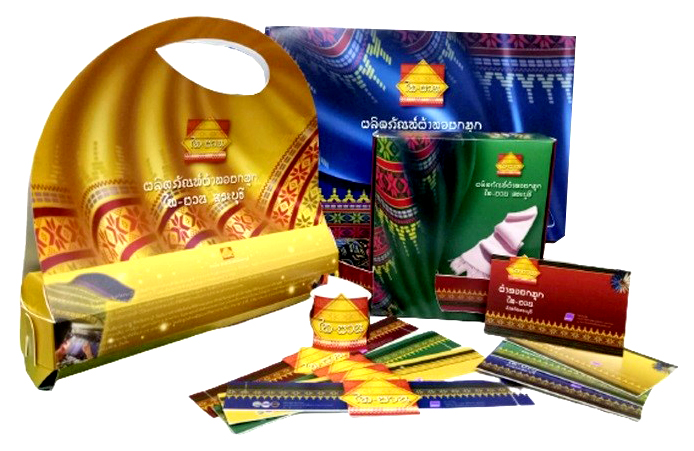Packaging design and development of contemporary products from the culture of ethnic Tai-Yuan: A case study of Tai-Yuan native textile, Saraburi Province
Main Article Content
Abstract
Baan TonTan Women Weaving Group, Sao Hai District, Saraburi Province. Production of local woven fabrics of the Tai-Yuan people which is a piece of cloth sarong and general pattern. The objective of this research is to design and create prototypes of packaging and contemporary products from cultural capital to meet the needs of consumers and creating social and cultural values of local identity. Including creating added value to the product It is a participatory action research process. from both academics Product design specialists, researchers, community leaders, philosophers of ethnic Tai-Yuan villages in Saraburi province and Baan TonTan weaving women with the following process 1) Create a conceptual framework and research process 2) Creation of new design ideas 3) Participation in product reviews and opinions 4) Packaging design and product development 5) Create patterns and produce prototypes of packaging and products; and 6) Evaluate consumer satisfaction. The community and the Baan TonTan weaving women group participated in formulating the design concept Prototyping and product development training. To increase skills in designing and laying out patterns in sewing. Color placement and fabrication of decorations to create beauty on the product. As a result of the operation, there are prototypes of packaging and products that convey the identity of the Tai-Yuan community. Saraburi. It consists of packaging prototypes of Tai-yuan traditional woven fabrics, 4 works and 2 types of contemporary product prototypes: 1) A set of bags for ladies, 7 works, and 2) 3 products of souvenirs for home decoration. As a result, it creates added value in selling woven fabrics. which can be sold at a 50% higher price and create jobs and income in the community.
Article Details

This work is licensed under a Creative Commons Attribution-NonCommercial-NoDerivatives 4.0 International License.
Area Based Development Research Journal values copyright protection and licensing to safeguard author rights and facilitate the appropriate dissemination of research. Our policies ensure openness, accessibility, and attribution. Authors retain copyright ownership, and articles are published under a Creative Commons Attribution License (CC BY), allowing sharing, adaptation, and proper attribution. Authors have the freedom to publish under the CC BY license, granting broad reuse and distribution permissions. The journal supports posting articles on third-party repositories, adhering to institutional and funding restrictions. Author guidelines detail copyright and licensing requirements, empowering authors with knowledge about their rights and responsibilities. These policies cultivate an environment of collaboration, openness, and responsible sharing, benefiting authors and the research community while honoring intellectual property rights.
References
Hornmano, P. (2015). The purchasing behavior on products of customers generation B, generation X and generation Y in modern retailers of Nakhon Ratchasima province. Journal of Business Administration. 4(1), 54-75. (in Thai).
Jenjai, N. (2020). Upgrading Kai-weaved textiles for cultural products of the Mae Loi Luang community, Chiang Rai province. Area Based Development Research Journal, 12(2), 144-155. (in Thai).
Kasetsart University. (2019). T1 community engagement. Retrieved January 12, 2021, from: http://www.ku.ac.th. (in Thai).
Kusalanon, R., Sukkoy, C., & Kaewtatip, A. (2021). Design and development of local woven fabrics to promote local identity and add value to cultural products in Chiang Saen community, Chiang Rai province. Area Based Development Research Journal, 13(1), 16-30. (in Thai).
Parmotmuang, M., Sukontachart, T., & Wongsuwan, S. (2017). Study, Thaiyoun cultural identity of Thailand for package design, local food, Street culture of Sao Hai district, Saraburi. (Research report). Bangkok: Rajamangala University of Technology Phra Nakhon. (in Thai).
Pliwjantuk, P. (2019). The study of Tai-Yuan’s identity at Amphor Sikhio into tourism support media design. (Master’s thesis). Faculty of Fine Arts and Design Arts, Silpakorn University. (in Thai).
Saraburi Provincial Cultural Office. (2018). Project for collecting intangible cultural heritage of 2018, Saraburi province. Saraburi: Saraburi Provincial Cultural Office. (in Thai).
Siamrath Online, (2021). Thai culture, local culture. Retrieved January 12, 2021, from: https://siamrath.co.th/n/25668. (in Thai).
Wanichakorn, A. (2016). Thai wisdom knowledge: Designed and created the contemporary products. Institute of Culture and Arts Journal, 15(2), 22-28. (in Thai).


